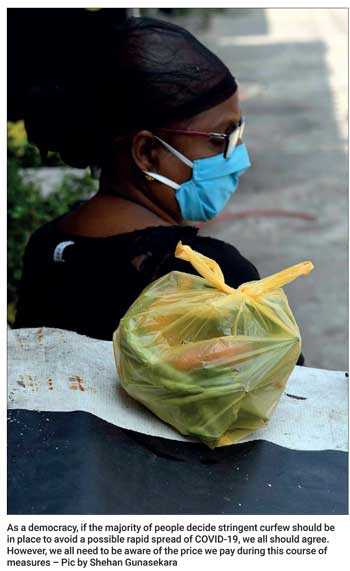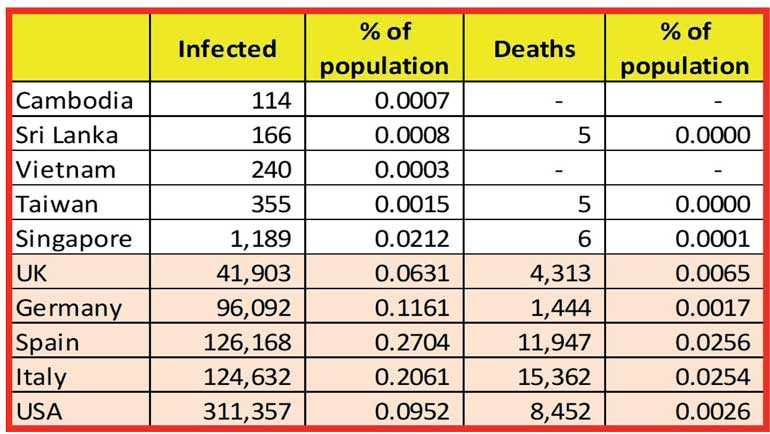Sunday Dec 14, 2025
Sunday Dec 14, 2025
Tuesday, 7 April 2020 00:10 - - {{hitsCtrl.values.hits}}
As the vast majority of Sri Lankans stay at home, the local media from morning to night gives a live commentary of the global spread of COVID-19 – how many died in USA, Italy and Spain, how many have got infected in Sri Lanka over the last 24 hours, etc. The impression one gets is that almost every other person is infected and that there’s a high chance of death.
Infection rate less than 0.3%, mortality rate less than 0.03%
A glance at the current statistics (referring to the same countries analysed in last week’s article – http://www.ft.lk/columns/COVID-19-Sri-Lanka-should-reassess-strategy-soon/4-698250) – shows that even Western countries which are worst affected, have less than 0.3% of the population infected by Covid-19 so far. The mortality rate of these countries is less than 0.03%. It is almost 0% so far in the Asian countries such as Singapore, Vietnam and Cambodia. 
While the worst case scenario in USA refers to total deaths of around 200,000, that is still around 0.06% of the population. That is one out of 1,667 people. Global statistics show that even out of infected, over 95% cases are mild in nature and less than 5% could become serious or critical.
In comparison, there are years in the recent past, where Sri Lanka recorded close to 200,000 cases of dengue, which works out close to 1% of the population. Hundreds have died from dengue in recent years (2017 in particular). However, did we have a live commentary in media of dengue cases then? Did we halt the economy and authorities visit every house and every establishment to check and destroy possible breeding locations every week?
Such measures may have saved hundreds of lives all these years as well. Instead, normal day-to-day life continued, so there wouldn’t have been unreported cases of people dying due to delays of surgeries or unavailability (or unaffordability) of essential medicine or stress/depression. Can we guarantee it’s not happening now when the only focus is on COVID-19?
Also as per health experts, if one takes precautions, washes hands regularly, keeps a distance of one metre from others and wears a mask, there’s little chance of anyone catching COVID-19. Therefore the responsibility lies with oneself, even if others misbehave.
Apparel, hotels and exporters battle for survival over next six months
Anyway, as a democracy, if the majority of people decide stringent curfew should be in place to avoid a possible rapid spread of COVID-19, we all should agree. However, we all need to be aware of the price we pay during this course of measures.
The initial impact of the economic shutdown was felt by the daily wage earners. The Government has already made payments of Rs. 5,000 to four million people at the expense of an extra Rs. 20 b to the Government. One could barely survive with Rs. 5,000 for three weeks. So more payments are needed if the curfew continues.
The disruption in Western economies has disrupted the demand for exports. Due to the loss of business, the largest Apparel companies have already announced salary cuts as much as 60% over the next few months. The same applies for the tourism sector. The virtual halt in global travel has plummeted earnings in the segment since the beginning of the year. These factors have nothing to do with the curfew imposed in Sri Lanka, but rather challenges emanating from the global situation.
Rs. 100-200 b needed to provide relief
These two sectors collectively earned close to $ 10 b in 2018. This could fall at least to $ 6 b in 2020 with almost zero earnings from April-June. The Government needs to consult and give support to ensure that these two sectors as well as other exporters survive the next six months and be ready for business, once demand picks up (we have to wish that the US and Europe are back in full operation by June/July).
The economic repercussions are severe if these businesses are allowed to go bankrupt permanently during this challenging three to six months. Even Sri Lanka defaulting on its foreign debt becomes a real possibility then.
The above-mentioned fall in foreign earnings have eroded the country’s importing capacity. Therefore the import restrictions that were announced recently were inevitable. Some of these import businesses may get wiped out in the coming months as the Government would simply not have the capacity to save everything due to its limited resources. Nevertheless, the Government would have to provide some relief over the next few months for all those who would be out of jobs (linked to the import sector), until they find employment in alternative sectors.
The banking sector has been instructed to provide relief by delaying repayments and offering lower interest rate loans. The banking sector may not have the capacity to bear all these concessions and the Government may have to bear the majority of that burden as well. Non-performing loans are certain to pile up and none of the banks could afford to go bankrupt, which could affect the whole financial system. Needless to say the unimaginable impact on depositors, businesses and the overall economy from such an outcome.
The above necessary measures could cost the Government at least Rs. 100 b or possibly around Rs. 200 b in the coming months.

Government tax revenue could fall by Rs. 600 b in 2020
The virtual halt of the economy over the last three weeks would have cost the Government close to Rs. 75 b of tax revenue. The expected plummeting of imports (which is a key source of tax income), lower corporate and personal income and general reduction in economic activity could lower tax revenue by a further Rs. 500 b during the course of 2020 (compared to 2019).
With such a steep fall in revenue, and the need to provide necessary concessions to certain segments, the Government has no option but to reduce expenditure in other fronts. The Government will not be able to reduce pensions, other social welfare expenditure and interest payments. The Government could halt all development activities and negotiate for debt repayment extensions which could save a maximum of Rs. 400 b. A 25% reduction in Government sector salaries for three months could save another Rs. 50 b.
This would still mean the Government would need to finance an extra Rs. 250 b (compared to 2019). The Central Bank may have to come up with innovative measures taken by developed countries for this purpose. Subsequent, inflationary effects will have to be ignored during these challenging times. The Government would also need aid from donors and friendly countries, which is not going to be easy as they all try to revive their own economies.
This is the optimistic scenario now
What we should realise is, the above is actually the optimistic scenario from now on. It depends on a partial opening of the economy by mid April and a full opening of the economy by mid May. The exporters may not have work due to absence of demand and importers may not have work due to the restrictions in place.
However, the other segments could gradually go back to work. This would ensure the other segments start making income and revenue streams open up for the Government. And the Government is relieved from giving concessions to these segments which are back in operation, and could focus on giving relief to the ones that are in dire need as mentioned above.
With the exception of a few segments, everyone else would need to undergo income reductions. Some of them could struggle with debt commitments. The ability of banks to provide concessions would be significantly limited by the ability of Government to support such measures.
Many businesses would make losses and some would have to close down. Most would see quality of life of their families and children fall in front of their eyes. Many who could afford medical care easily a month ago would not be able to afford it over the next few months. Elevated levels of stress and depression are likely in thousands of families. How many lives this could cost, we do not know. Again, this is the best case scenario from now on.
Extension of curfew would only make the stakes even steeper. As a democracy, if the majority of the population is of the opinion that this is a price they are willing to pay, so be it. It’s still naive to compare Sri Lanka with US and Europe and claim we have done better. It has not ended, it’s just starting. We will know exactly where each country stands in six to 12 months. Let’s take responsibility for our actions today and remember not to complain then.
(The writer can be contacted on [email protected].)